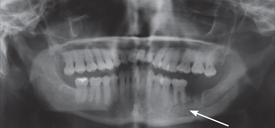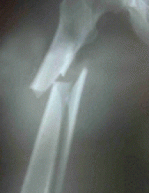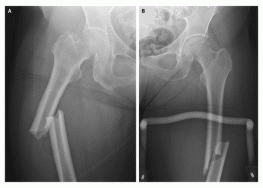Fosamax Study Denies
Link with Femur Fractures
by Jeffrey Dach MD
A recent NEJM article by Dennis Black MD denying a link between Fosamax and spontaneous mid-femur fractures has many doctors raising their eyebrows. Firstly, there is the problem of conflict of interest. The study was funded by Fosamax maker, Merck, and the authors are all on Merck’s payroll. Left Image: Spontaneous mid femur fracture courtesy of Jennifer P. Schneider, MD, PhD (7).
Secondly, a number of flaws in the study are brought out by Dr Elizabeth Shane who says in a NEJM Editorial: No Xray data was presented, although every patient with a fracture had xrays. The women were on Fosamax for shorter time and lower dosage required to generate the femur fractures. The statistics of the study was questioned.
Left image fosamax induced fractures courtesy of Dr Lane Nejm. Radiographs of Spontaneous Fractures of the Femoral Shaft Showing the “Simple with Thick Cortices” Pattern.
In spite of Dr Black’s reassuring report, Dr Elizabeth Shane still recommends a drug holiday. This is a polite way of saying, “STOP THE DRUG”. Dr Shane says: “it is reasonable to consider drug holidays “.
My Advice:
My advice is to stay away from bisphosphonate drugs. These are “Bad Drugs” which should never have been approved for human use.
More Questions:
I have a few more questions and comments about Dr Black’s NEJM report.
 1) The patient data was not stratified according to T score. The FIT trial showed increased fracture rates in patients on Fosamax with T scores greater than -2.5. Fosamax doubled the hip fracture rate in this group (T score above -2.5) from 6 to 11.
1) The patient data was not stratified according to T score. The FIT trial showed increased fracture rates in patients on Fosamax with T scores greater than -2.5. Fosamax doubled the hip fracture rate in this group (T score above -2.5) from 6 to 11.
2) Although there were 284 hip fractures, 135 were excluded from the data for various reaons, and only 12 were accepted as spontaneous mid-femur fractures. Whenever data is excluded from a data set, this arouses suspicion and a red flag of possible data manipulation.
Another question: since there was no Xray data, how can the fractures be reviewed and excluded without this? If there was Xray review, then why wasn’t this data included in the study?
3) Why do the results of Dr Dennis Black contrast with the many reported case series on Fosamax induced spontaneous femur fractures from Joseph Lane, Odvina and Goh (and many others).
Dr Black’s results run opposite to the reported experience of the medical community. Physicans are seeing and reporting more cases of atypical femur fractures on Fosamax. These are spontaneous fractures with no trauma indicating underlying pathologic bone formation. We never saw these before the fosamax era.
4) Why do the results of Dr Dennis Black contrast with bone histology studies that show abnormal bone formation on Fosamax, reporting “microdamage accumulation and reduced some mechanical properties of bone”.
5) Why are these spontaneous mid-femur fractures happening at all ? Doesn’t this indicate a severe problem with the underlying bone physiology? The bisphosphonate drug is producing abnormal, pathological bone demonstrated on histology slides. Dr Black’s report does not address this question.
 Osteo-Necrosis of the Jaw Reported by Dentists
Osteo-Necrosis of the Jaw Reported by Dentists
6) What about reports of a link with Osteonecrosis of the Jaw, another example of fosamax disturbing bone physiology, making the bones weaker, not stronger. Dr Black’s report does not address this issue. Left Image : Radiograph of bisphosphonate-related osteonecrotic lesion at extraction site of tooth #18. Lesion extends to the apices of adjacent tooth #19. courtesy of AFP editorial.
Bottom line: Dr Black’s report is unconvincing. Especially unconvinced are the increasing numbers of women presenting to the orthopedic surgeons with spontaneous femur fractures on fosamax. These fractures are devastating and do not heal. My advice is to stay away from bisphosphonate drugs. These are “Bad Drugs” which should never have been approved for human use.
Effective Natural Treatments for Osteoporosis
Number one: Avoid the bisphosphonate drugs. These are “Bad Drugs”..
This is the list to avoid:
Alendronate (Fosamax)
Risedronate (Actonel)
Ibandronate (Boniva)
Zoledronic acid (Reclast)
Number two: Use a nutritional supplement program including a full range of nutrients to build strong bone, Vitamin K1 and K2, Vitamin D3, Calcium, Magnesium, Boron, Strontium, trace minerals, vitamin C, silica, etc.
Number three: If you are in the post-menopause age group, consider bioidentical hormone replacement. Bone loss is directly caused by post-menopausal hormone deficiency. A robust bioidentical hormone replacement program maintains healthy muscle mass and bone density.
Number four: Test for other common causes of osteoporosis such as gluten sensitivity and calcium malabsorption. Magnesium deficiency , and calcium malabsorption may be caused by gluten sensitivity, gluten enteropathy and celiac disease. Our routine lab panel includes testing for gluten sensitively.
Number Five: Lifestyle Changes: Modify Diet to alkaline diet Use the helpful food chart in this article: Acid_Alkaline Balance and Its Effect on Bone Health by Susan E Brown Russell Jaffe. Eliminate foods which cause osteoporosis such as phosphate containing colas, eliminate cigarette smoking, etc. Make sure you have a good exercise program to maintain good muscle mass. For more on this, see my article on Reverse Osteoporosis Naturally Without Drugs.
This article is part two, for part one click here.
Articles with Related Content :
FDA Says Osteoporosis Drugs Cause Femur Fractures
Fosamax, a Bad Drug in Litigation
Fosamax, Osteoporosis and Toulouse Lautrec
Fosamax induced Femur Fractures More Bad News
Bisphosphonates for Osteoporosis, A Closer Look at the Data
Osteoporosis Drugs Cause Osteo-Necrosis of the Jaw
Links and References
1) http://content.nejm.org/cgi/content/full/NEJMe1003064
Evolving Data about Subtrochanteric Fractures and Bisphosphonates Elizabeth Shane, M.D. – it is reasonable to consider drug holidays with careful observation for most patients with osteoporosis who are receiving long-term therapy
2) http://content.nejm.org/cgi/content/full/NEJMoa1001086
Bisphosphonates and Fractures of the Subtrochanteric or Diaphyseal Femur Dennis M. Black, Ph.D., Michael P. Kelly, M.D., Harry K. Genant, M.D., Lisa Palermo, M.A., Richard Eastell, M.D., Christina Bucci-Rechtweg, M.D., Jane Cauley, Ph.D., Ping Chung Leung, M.D., Steven Boonen, M.D., Ph.D., Arthur Santora, M.D., Anne de Papp, M.D., Douglas C. Bauer, M.D., for the Fracture Intervention Trial and HORIZON Pivotal Fracture Trial Steering Committees Conclusions The occurrence of fracture of the subtrochanteric or diaphyseal femur was very rare, even among women who had been treated with bisphosphonates for as long as 10 years. There was no significant increase in risk associated with bisphosphonate use, but the study was underpowered for definitive conclusions.
Conflict-of-Interest?
Dr. Black reports to the NEJM that he is receiving grants (to UCSF) from Merck, Novartis, Amgen, and Roche and travel reimbursements from Merck and Novartis, who also supported the research. The study was sponsored by Merck and Novartis. Several other authors work for the companies, while others consult and receive compensation for their work from the makers of bisphosphonates.
3) http://courses.washington.edu/bonephys/opsubtroch.html
Subtrochanteric fractures- Susan Ott md
Reports of Spontaneous Femur Fractures
4) http://content.nejm.org/cgi/content/full/358/12/1304
NEJM V358:1304-1306 March 20, 2008 Number 12
Atypical Fractures of the Femoral Diaphysis in Postmenopausal Women Taking Alendronate Brett A. Lenart, B.S., Dean G. Lorich, M.D. ,Joseph M. Lane, M.D. ,Weill Cornell Medical College ,New York, NY 10021
5) http://jcem.endojournals.org/cgi/content/abstract/90/3/1294
Odvina CV, Zerwekh JE, Rao DS, Maalouf N, Gottschalk FA, Pak CY. Severely suppressed bone turnover: a potential complication of alendronate therapy. J Clin Endocrinol Metab 2005;90:1294-1301.
6) http://www.ncbi.nlm.nih.gov/pubmed/17356148
Goh SK, Yang KY, Koh JS, et al. Subtrochanteric insufficiency fractures in patients on alendronate therapy: a caution.
J Bone Joint Surg Br 2007;89:349-353.
More Reports
7) Schneider, Jennifer P. “Bisphosphonates and low-impact femoral fractures: current evidence on alendronate-fracture risk.” Geriatrics 64.1 (2009): 18-23. Bisphosphonates Femur Fracture Jennifer P Schneider January 2006 Volume 61 Number 1 Geriatrics
8) http://www.ncbi.nlm.nih.gov/pubmed/18222447
An emerging pattern of subtrochanteric stress fractures: A long-term complication of alendronate therapy?§ Ernest Beng Kee Kweka,*, Seo Kiat Goh a, Joyce Suang Bee Koh a,
Meng Ai Png b, Tet Sen Howe Department of Orthopaedic Surgery, Singapore General Hospital, Outram Road, Singapore 169608, Singapore Department of Diagnostic Radiology, Singapore General Hospital, Outram Road, Singapore 169608, Singapore August 2007
Injury, Int. J. Care Injured (2008) 39, 224—231
9) http://www.jenniferschneider.com/articles/Bisphosphonates.pdf
Bisphosphonates and low-impact femoral fractures: Current evidence on alendronate-fracture risk Jennifer P. Schneider, MD, PhD
10) http://www.ncbi.nlm.nih.gov/pubmed/19884427
J Bone Joint Surg Am. 2009 Nov;91(11):2556-61.
Bilateral low-energy simultaneous or sequential femoral fractures in patients on long-term alendronate therapy. Capeci CM, Tejwani NC.Department of Orthopaedic Surgery, New York University Hospital for Joint Diseases, 301 East 17th Street, Suite 1401, New York, NY 10003, USA.
11) http://www.ncbi.nlm.nih.gov/pubmed/19198962
Clin Orthop Relat Res. 2009 Jul;467(7):1921-6. Epub 2009 Feb 6.
Case reports: two femoral insufficiency fractures after long-term alendronate therapy. Sayed-Noor AS, Sjödén GO.Department of Orthopaedic Surgery, Sundsvall Hospital, 851 86 Sundsvall, Sweden.
12) http://www.ncbi.nlm.nih.gov/pubmed/19670917
Drug Saf. 2009;32(9):775-85. doi: 10.2165/00002018-200932090-00002.
Low-energy femoral fractures associated with the long-term use of bisphosphonates: a case series from a Swiss university hospital.
Ing-Lorenzini K, Desmeules J, Plachta O, Suva D, Dayer P, Peter R.
Division of Clinical Pharmacology and Toxicology, Regional Pharmacovigilance Centre, University Hospitals of Geneva, Geneva, Switzerland.
13) http://www.ncbi.nlm.nih.gov/pubmed/20020334
Clin Orthop Relat Res. 2009 Dec 18. [Epub ahead of print]
Case Reports: Subtrochanteric Femoral Stress Fractures after Prolonged Alendronate Therapy. Cermak K, Shumelinsky F, Alexiou J, Gebhart MJ.
Department of Orthopedic Surgery, Institut Jules Bordet, Université Libre de Bruxelles, 1 rue Heger-Bordet, 1000, Brussels, Belgium,
Bone Histology studies
14) http://www3.interscience.wiley.com/journal/123292394/abstract
Suppressed Bone Turnover by Bisphosphonates Increases Microdamage Accumulation and Reduces Some Biomechanical Properties in Dog Rib , Journal of Bone and Mineral Research Volume 15 Issue 4, Pages 613 – 620 Published Online: 18 Feb 2010 by Tasuku Mashiba 1, Toru Hirano 1, Charles H. Turner 1, Mark R. Forwood 2, C. Conrad Johnston 3, David B. Burr, Ph.D. 1 *
1Departments of Anatomy and Cell Biology, and Orthopaedic Surgery, Biomechanics and Biomaterials Research Center, Indiana University School of Medicine, Indianapolis
It has been hypothesized that suppression of bone remodeling allows microdamage to accumulate, leading to increased bone fragility. This study evaluated the effects of reduced bone turnover produced by bisphosphonates on microdamage accumulation and biomechanical properties of cortical bone in the dog rib. Thirty-six female beagles, 1-2 years old, were divided into three groups. The control group (CNT) was treated daily for 12 months with saline vehicle. The remaining two groups were treated daily with risedronate (RIS) at a dose of 0.5 mg/kg per day or alendronate (ALN) at 1.0 mg/kg per day orally. After sacrifice, the right ninth rib was assigned to cortical histomorphometry or microdamage analysis. The left ninth rib was tested to failure in three-point bending. Total cross-sectional bone area was significantly increased in both RIS and ALN compared with CNT, whereas cortical area did not differ significantly among groups. One-year treatment with RIS or ALN significantly suppressed intracortical remodeling (RIS, 53%; ALN, 68%) without impairment of mineralization and significantly increased microdamage accumulation in both RIS (155%) and ALN (322%) compared with CNT. Although bone strength and stiffness were not significantly affected by the treatments, bone toughness declined significantly in ALN (20%). Regression analysis showed a significant nonlinear relationship between suppressed intracortical bone remodeling and microdamage accumulation as well as a significant linear relationship between microdamage accumulation and reduced toughness. This study showed that suppression of bone turnover by high doses of bisphosphonates is associated with microdamage accumulation and reduced some mechanical properties of bone.
15) http://www.annals.org/content/144/10/753.abstract
Systematic Review: Bisphosphonates and Osteonecrosis of the Jaws
Sook-Bin Woo, DMD; John W. Hellstein, DDS, MS; and John R. Kalmar, DMD, PhD. Annals of Internal Med May 16, 2006 vol. 144 no. 10 753-761
16) Bisphosphonate-Related Osteonecrosis of the Jaw in Patients with Osteoporosis by CHRISTINE HENG, DDS, MPH, U.S. Public Health Service, Federal Correctional Institution, Danbury, Connecticut VICTOR M. BADNER, DMD, MPH, and TASIOS G. VAKKAS, DDS, MD, Jacobi Medical Center, Bronx, New York ROSEMARY JOHNSON, APRN, C-ANP, MSN, U.S. Public Health Service, Federal Correctional Institution, Danbury, Connecticut YVON YEO, PharmD, Stamford Hospital, Stamford, Connecticut Am Fam Physician. 2012 Jun 15;85(12):1134-1141.
17) more on Bisphosphonate related osteonecrosis of jaw.
18) Acid_Alkaline Balance and Its Effect on Bone Health by Susan E Brown Russell Jaffe International Journal of Integrative Medicine 2000 Acid-Alkaline Balance and Its Effect on Bone Health by Susan E. Brown, Ph.D., CCN, and Russell Jaffe, MD, Ph.D., CCN, International Journal of Integrative Medicine, Vol. 2, No. 6 Nov/Dec 2000
Jeffrey Dach MD
7450 Griffin Road Suite 190
Davie, Fl 33314
954-792-4663
http://www.drdach.com
http://www.naturalmedicine101.com
http://www.truemedmd.com
Disclaimer click here: http://www.drdach.com/wst_page20.html
The reader is advised to discuss the comments on these pages with his/her personal physicians and to only act upon the advice of his/her personal physician. Also note that concerning an answer which appears as an electronically posted question, I am NOT creating a physician — patient relationship. Although identities will remain confidential as much as possible, as I can not control the media, I can not take responsibility for any breaches of confidentiality that may occur.
Link to this article: http://wp.me/p3gFbV-2H4
Copyright (c) 2010-2015 Jeffrey Dach MD All Rights Reserved. This article may be reproduced on the internet without permission, provided there is a link to this page and proper credit is given.
FAIR USE NOTICE: This site contains copyrighted material the use of which has not always been specifically authorized by the copyright owner. We are making such material available in our efforts to advance understanding of issues of significance. We believe this constitutes a ‘fair use’ of any such copyrighted material as provided for in section 107 of the US Copyright Law. In accordance with Title 17 U.S.C. Section 107, the material on this site is distributed without profit to those who have expressed a prior interest in receiving the included information for research and educational purposes.
The post Fosamax Study Denies Link with Femur Fractures appeared first on Jeffrey Dach MD .











Leave a Comment
You must be logged in to post a comment.